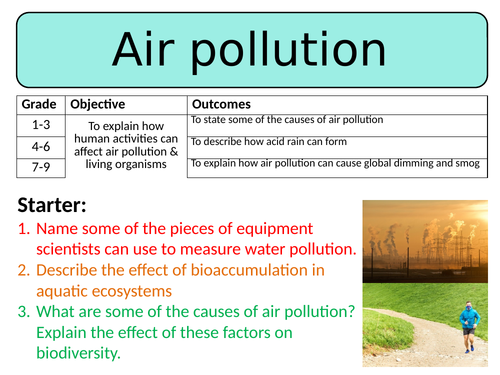
This lesson is designed for the NEW AQA Trilogy Biology GCSE, particularly the ‘Ecology’ SoW.
For more lessons designed to meet specification points for the NEW AQA Trilogy specifications for Biology, Chemistry and Physics please see my shop: https://www.tes.com/teaching-resources/shop/SWiftScience
The first part of the lesson asks students to think > pair > share some of their answers to questions about pollution - where does it come from? How may we monitor it? Once pupils have gathered together their ideas as groups, a class discussion can highlight some of the important ideas & the next slide details the answers.
The next task focuses on sulfur dioxide pollution and it’s contribution to the formation of acid rain. Pupils will be given some information in pairs about this pollutant and will be required to answer questions about this information in their books. Once completed pupils are able to self-assess their work using the answers provided in the PowerPoint.
The next part of the lesson is on catalytic converters, pupils will be given some information about a catalytic converter and a human bingo grid. Pupils will wander around the room and others will ask them questions in order to fill in their bing grid. Once a student has completed their grid they can shout bingo! When everyone has had enough time to complete the grid they will need to self-assess their work using the answers provided.
The next task is for pupils to consider alternative fuels as a way of reducing air pollution. Pupils are given sets of information about three alternative fuels, they will then need to fill in a table of the advantages and disadvantages of these fuels. Once completed pupils can check their work against the answers provided, marking and correcting their answers.
A mid-lesson progress check requires pupils to identify whether a set of statements are true or false, this can be completed with a mini whiteboard or in their books.
The next part of the lesson focuses on how scientists can monitor pollution, pupils are given a set of results from particle collector pads which have been left in certain locations around the UK. Pupils need to record their results in a table, draw a graph to represent the results and write a conclusion about their results.
The plenary task is for pupils to complete a fill-in-the-blanks task on air pollution, pupils can also self-assess their work using the answers provided.
All resources are included at the end of the presentation. Thanks for looking, if you have any questions please let me know in the comments section and any feedback would be appreciated :)
Get this resource as part of a bundle and save up to 56%
A bundle is a package of resources grouped together to teach a particular topic, or a series of lessons, in one place.
Something went wrong, please try again later.
Thank you. Had a technical hitch but sorted very quickly. Thanks for a great resource!
Report this resourceto let us know if it violates our terms and conditions.
Our customer service team will review your report and will be in touch.
